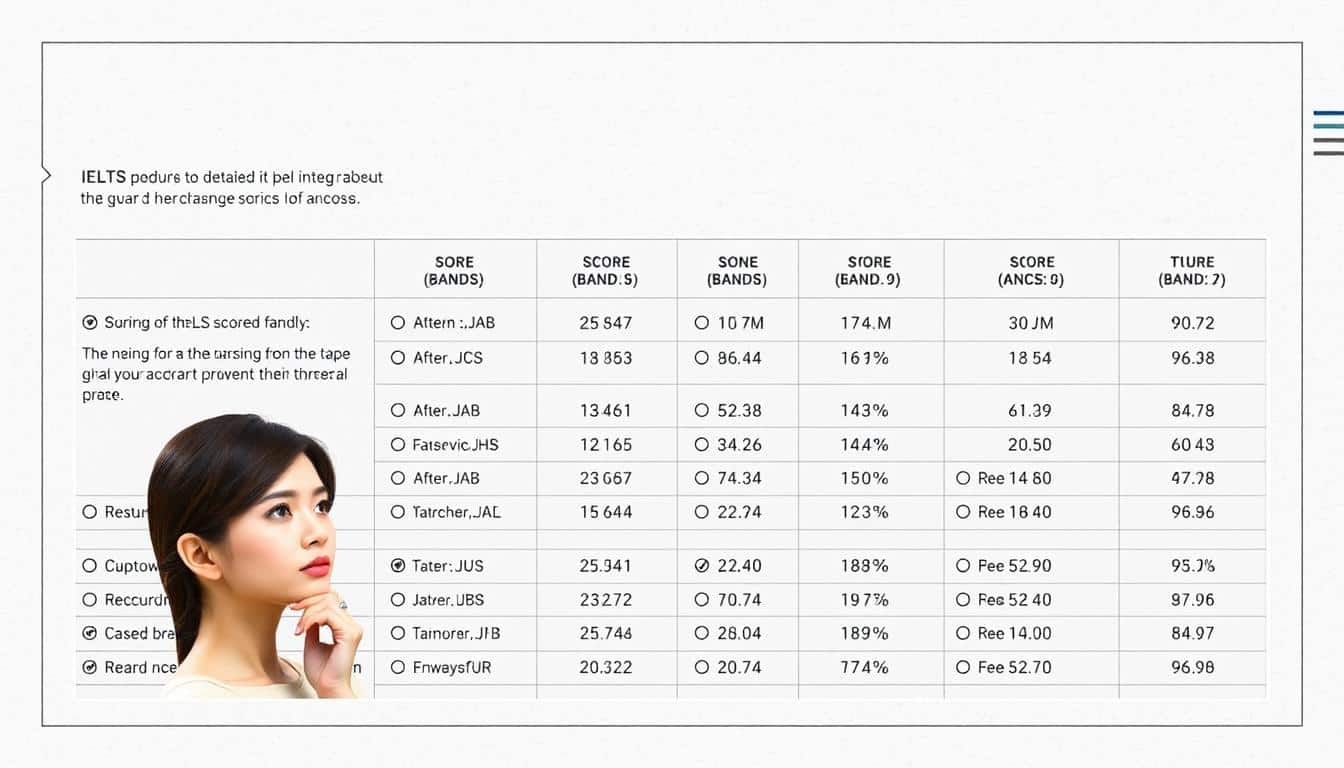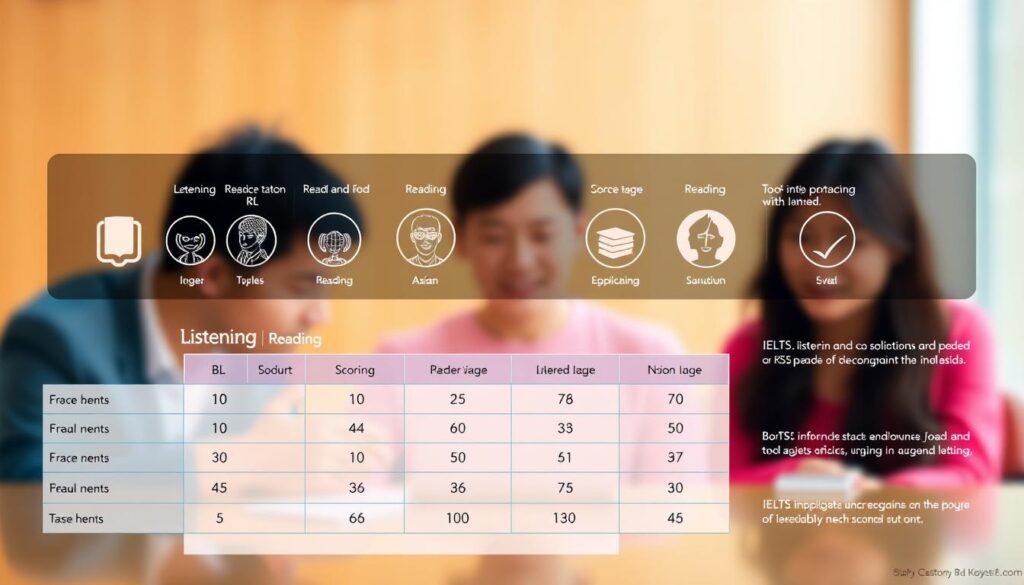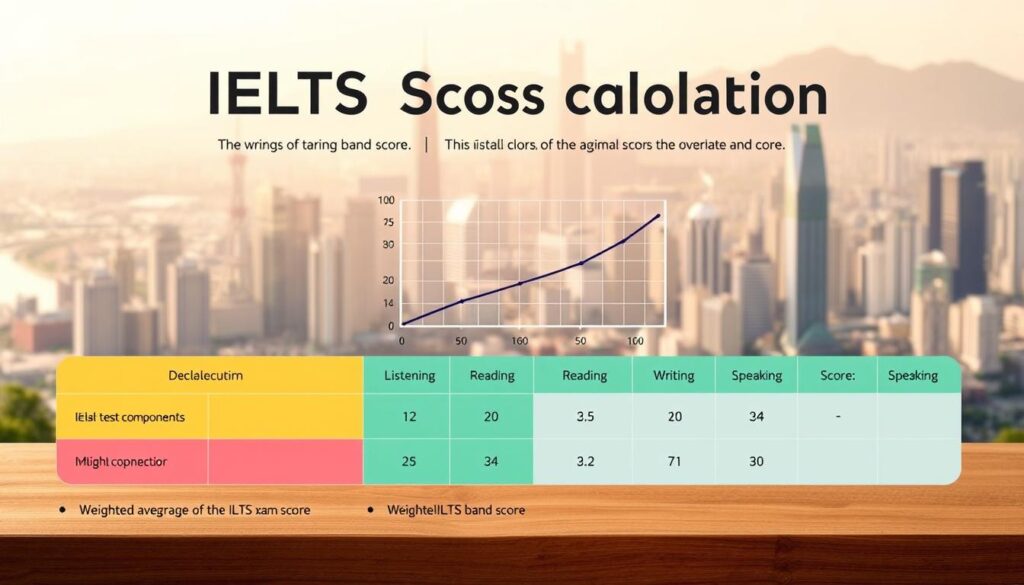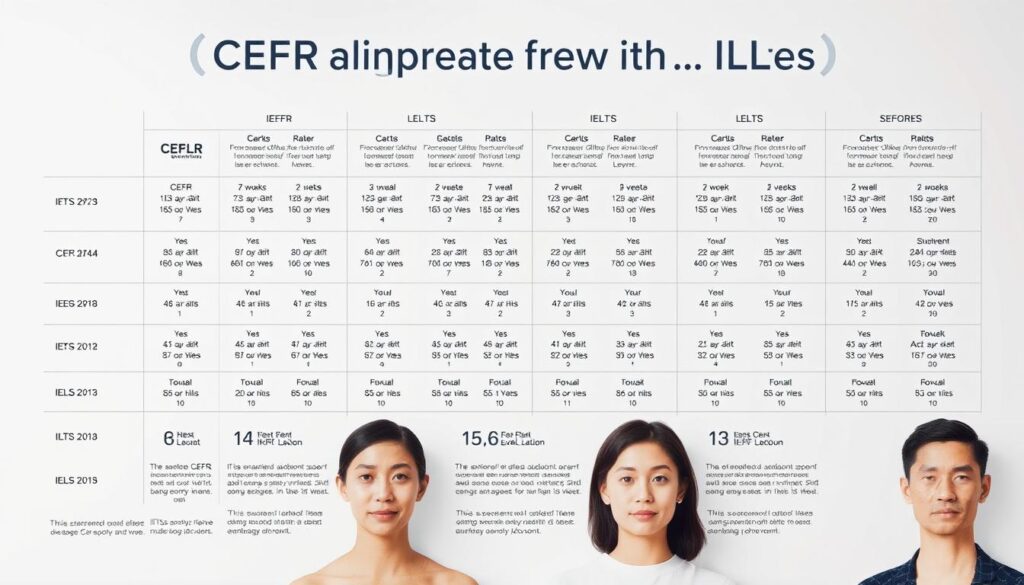Are you preparing for the IELTS test and wondering how your performance is measured? Look no further! This guide breaks down the IELTS scoring system, helping you understand how your skills in Listening, Reading, Writing, and Speaking are assessed.
Your IELTS results include individual scores for each section, along with an overall band score. These scores range from 0 to 9, reflecting your English proficiency. The overall score is the average of the four sections, rounded to the nearest half band. For example, a 6.25 becomes 6.5, while a 6.75 becomes 7.0.
Each section is scored based on specific criteria. Listening and Reading each have 40 questions, with each correct answer worth 1 mark. Writing tasks are assessed on task achievement, coherence, vocabulary, and grammar, while Speaking is evaluated on fluency, pronunciation, and lexical resource.
Understanding your IELTS score is crucial for academic or career opportunities. Many universities and employers require specific band scores, making it essential to aim for your target. Whether you’re applying for a student visa or seeking job opportunities, a strong IELTS score can open doors.
Key Takeaways
- IELTS scores range from 0 to 9, measuring English proficiency across four sections.
- Overall score is the average of Listening, Reading, Writing, and Speaking, rounded to the nearest half band.
- Listening and Reading sections each have 40 questions, with each correct answer worth 1 mark.
- Writing is assessed on task achievement, coherence, vocabulary, and grammar.
- Speaking evaluates fluency, pronunciation, and lexical resource.
- Specific band scores are often required for university admission and job applications.
- A strong IELTS score enhances opportunities for education and employment.
For expert guidance on improving your IELTS performance, visit getutor.com.hk and unlock your full potential.
Comprehensive Overview of IELTS Band Scores
Understanding how your IELTS performance is translated into band scores is key to achieving your target. The IELTS scoring system is designed to assess your English proficiency across four sections: Listening, Reading, Writing, and Speaking. Each section is scored individually, and the overall band score is the average of these four sections, rounded to the nearest half band.
Understanding Sectional Scores: Listening, Reading, Writing, and Speaking
The Listening and Reading sections each consist of 40 questions, with each correct answer worth 1 mark. For example, in Listening, a Band 5 corresponds to approximately 16 correct answers out of 40, while a Band 7 might require around 30 correct answers. Similarly, in Reading, the number of correct answers needed to achieve a specific band score varies slightly between Academic and General Training tests.
Writing and Speaking are assessed based on specific criteria. Writing tasks are evaluated on task achievement, coherence, vocabulary, and grammar, while Speaking is assessed on fluency, pronunciation, and lexical resource. Each criterion is scored individually, and the overall score for these sections is the average of these assessments.
Converting Marks to IELTS Band Scores
The conversion of marks to band scores is straightforward for Listening and Reading. For instance, in Academic Reading, a Band 5 requires 15 correct answers, while a Band 6 demands 23 correct answers. In General Training Reading, the thresholds are slightly different, with a Band 5 requiring 23 correct answers and a Band 6 needing 30. This variation ensures the test caters to different English proficiency needs.
For Writing and Speaking, the process is criterion-based. Each task is scored on a scale from 0 to 9, and the final score is the average of these assessments. This ensures a balanced evaluation of your English skills.
Understanding how your marks translate to band scores can help you set realistic goals. For example, aiming for a Band 7 in Listening might require around 30 correct answers. This insight allows you to focus your study efforts effectively, ensuring you meet your target score.
By grasping the scoring system, you can better prepare for the test and understand what examiners are looking for. Whether it’s improving your listening skills or enhancing your writing coherence, knowing the criteria can guide your study plan. Remember, consistent practice and focused preparation are key to achieving your desired IELTS band score.
Exploring what is ielts score: Calculation Methods and Metrics
Your IELTS results are calculated by averaging scores from four sections: Listening, Reading, Writing, and Speaking. Each section is scored from 0 to 9, and the overall score is rounded to the nearest half band.
Rounding Rules and Overall Score Calculation Explained
The rounding rules for IELTS scores ensure fairness. For example, an average of 6.25 becomes 6.5, while 6.75 rounds up to 7.0. This system provides a clear and consistent way to determine your final score.
- The overall score is the average of all four sections.
- Scores are rounded to the nearest half band for final results.
Understanding how your score is calculated can help you prepare effectively. For instance, aiming for a 7.0 in Listening might require around 30 correct answers out of 40. This insight guides your study plan and helps you meet your target.
By understanding the scoring system, you can better prepare for the test. Whether improving your Listening skills or enhancing your Writing coherence, knowing the criteria can guide your study plan. Remember, consistent practice and focused preparation are key to achieving your desired score.
Detailed Analysis of Band Score Descriptors and Assessment Criteria
Understanding the IELTS band score descriptors and assessment criteria is essential for improving your test performance. Each section—Writing and Speaking—is evaluated based on specific criteria that help examiners determine your proficiency level. These criteria are evenly weighted, ensuring a balanced assessment of your skills.
Assessment Criteria for Writing and Speaking Tasks
For Writing, examiners assess four key areas: task achievement, coherence and cohesion, lexical resource, and grammatical range and accuracy. Each criterion contributes 25% to your final score. Similarly, Speaking is evaluated on fluency and coherence, lexical resource, grammatical range and accuracy, and pronunciation. These criteria are also equally weighted.
| Criteria | Writing | Speaking |
|---|---|---|
| Task Achievement/Fluency | How well you address the task | How smoothly you speak |
| Coherence and Cohesion | How logically your ideas flow | How well your speech is organized |
| Lexical Resource | Vocabulary range and accuracy | Vocabulary range and accuracy |
| Grammatical Range and Accuracy | Grammar and error frequency | Grammar and error frequency |
| Pronunciation | N/A | Clarity of speech |
Interpreting Band Descriptors and Marking Standards
Band descriptors provide detailed explanations of what each score represents. For example, a Band 7 in Writing indicates good command with some inaccuracies, while a Band 8 shows very good command. Understanding these descriptors helps you identify areas for improvement. As one expert notes:
Consistency in practice and focused preparation are key to achieving your target band score.
By understanding the criteria and how they are assessed, you can tailor your study plan to address weaknesses and enhance your strengths. This insight not only boosts your confidence but also helps you approach the test with a clear strategy.
Remember, each criterion plays a crucial role in determining your final score. Focus on improving all areas to achieve a high IELTS band score and unlock your educational and professional opportunities.
Strategies to Boost Your IELTS Test Results
Preparing for the IELTS test? Discover effective techniques to enhance your performance and achieve your desired band score. Here’s how you can improve your skills in each section:
Effective Preparation Techniques for Each Section
Start by understanding each section’s requirements. For Listening, focus on catching keywords and practicing with various accents. Try solving multiple-choice and matching questions to build speed and accuracy. In Reading, work on skimming and scanning techniques to manage time effectively. Regularly practice with sample tests to get familiar with question types and formats.
For Writing, concentrate on task achievement and coherence. Practice writing essays and reports, ensuring your grammar and vocabulary are strong. Speaking requires fluency and clear pronunciation. Record yourself speaking on different topics and listen for areas to improve. Consistent practice will help you feel more confident on test day.
| Section | Techniques |
|---|---|
| Listening | Practice with varied accents; focus on keywords and sentence completion exercises. |
| Reading | Master skimming and scanning; practice with timed exercises to improve speed. |
| Writing | Enhance task achievement and grammar; practice writing under timed conditions. |
| Speaking | Improve fluency and pronunciation; use recording tools for self-assessment. |
Remember, targeted practice and time management are key to boosting your band score. For personalized guidance, visit getutor.com.hk to explore expert resources and unlock your full potential.
Linking IELTS Scores to Global Standards and the CEFR
Understanding how IELTS scores align with global language standards is crucial for test-takers. The Common European Framework of Reference (CEFR) provides a widely recognized standard for language proficiency, making it easier to compare scores across different tests.
Understanding the CEFR Alignment and Its Importance
The CEFR framework consists of six levels: A1 (Basic), A2 (Elementary), B1 (Intermediate), B2 (Upper-Intermediate), C1 (Advanced), and C2 (Proficiency). These levels help standardize language proficiency globally.
IELTS band scores are mapped to CEFR levels through extensive research. For example, an IELTS band score of 7.0 corresponds to a CEFR C1 level, indicating advanced English proficiency.
- Global relevance of IELTS and CEFR ensures consistent language assessment standards.
- CEFR’s six levels provide a clear framework for measuring language skills.
- IELTS scores are aligned with CEFR levels, aiding universities and employers in evaluating candidates.
- Examples of correlations include IELTS 7.0 aligning with CEFR C1 and IELTS 5.5 with CEFR B2.
- This alignment is vital for academic and professional opportunities worldwide.
By understanding this alignment, test-takers can better prepare and interpret their IELTS results within a global context, making it a valuable tool for education and career advancement.
Conclusion
Mastering the IELTS scoring system is the first step toward achieving your goals. This guide has covered everything from how scores are calculated to strategies for improvement. Remember, your overall band score is the average of Listening, Reading, Writing, and Speaking, rounded to the nearest half band. Understanding the assessment criteria for each section can help you focus your practice effectively.
Whether you’re aiming for a specific band score or looking to improve your English skills, consistent practice is key. Use the strategies outlined here to enhance your performance in each section. From catching keywords in Listening to refining your vocabulary in Writing, every effort counts. Don’t forget, your score is not just a number—it’s a gateway to new opportunities.
Take charge of your preparation today. Review the sections that matter most to you and stay motivated. With the right approach, you can unlock your full potential and achieve the band score you need for success.
FAQ
How is the overall IELTS score calculated?
The overall IELTS score is the average of your sectional scores (Listening, Reading, Writing, and Speaking). Each section is scored on a band scale from 0 to 9. The scores are rounded to the nearest half or whole number to determine your final result.
What is the difference between Academic and General Training tests?
The Academic test is for students seeking higher education or professional registration. The General Training test is for those migrating to English-speaking countries or seeking work or training. Both tests share the same Listening and Speaking sections but differ in Reading and Writing tasks.
How are Listening and Reading scores converted to band scores?
Listening and Reading tests are scored based on the number of correct answers. Each correct answer earns 1 mark, with the total marks converted to a band score using a predefined table. There’s no negative marking for incorrect answers.
What are the assessment criteria for Writing and Speaking tasks?
Writing is assessed on Task Achievement, Coherence and Cohesion, Lexical Resource, and Grammatical Range and Accuracy. Speaking is evaluated on Fluency, Coherence, and Pronunciation, as well as Lexical Resource and Grammatical Range.
How does the Common European Framework of Reference (CEFR) align with IELTS scores?
IELTS scores align with the CEFR levels. For example, a band score of 4.5 corresponds to B1 (Intermediate), while a band score of 7.0 corresponds to B2 (Upper-Intermediate). This alignment helps universities and employers understand your English proficiency level.
Can IELTS scores be rounded up or down?
Yes, scores are rounded to the nearest half or whole band. For example, if your average is 6.25, it will be rounded to 6.5. If it’s 6.75, it will be rounded to 7.0. This ensures a fair and consistent scoring system.
How can I improve my IELTS band score?
Focus on effective preparation by practicing each section regularly. Enhance your vocabulary, work on coherence in Writing, and improve fluency in Speaking. Use official study materials and seek feedback from instructors to identify and address weaknesses.
What is the range of IELTS scores?
IELTS scores range from 0 to 9, with each band representing a specific level of English proficiency. The average score is rounded to the nearest half or whole number, ensuring a clear and precise result for test-takers.







